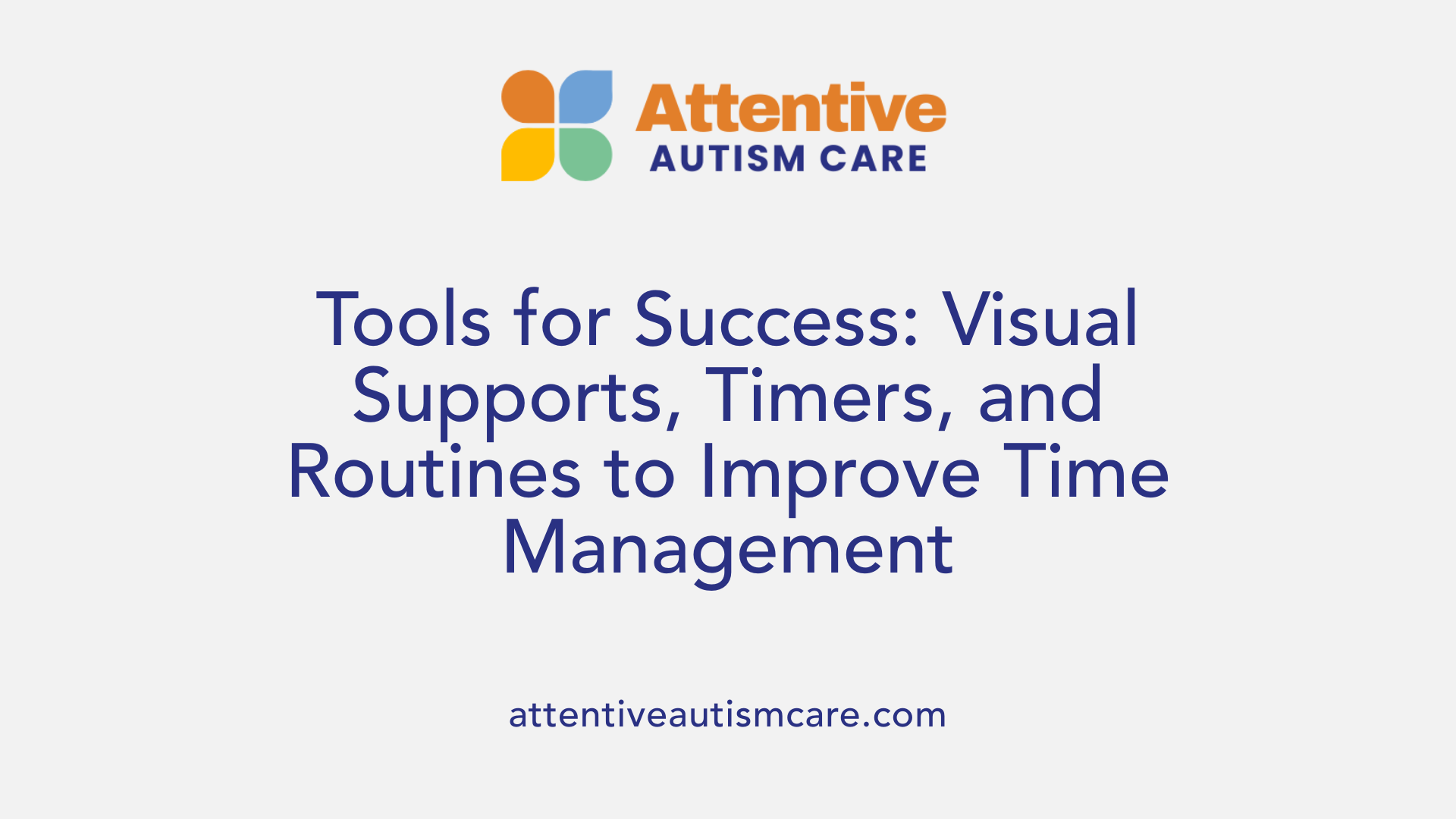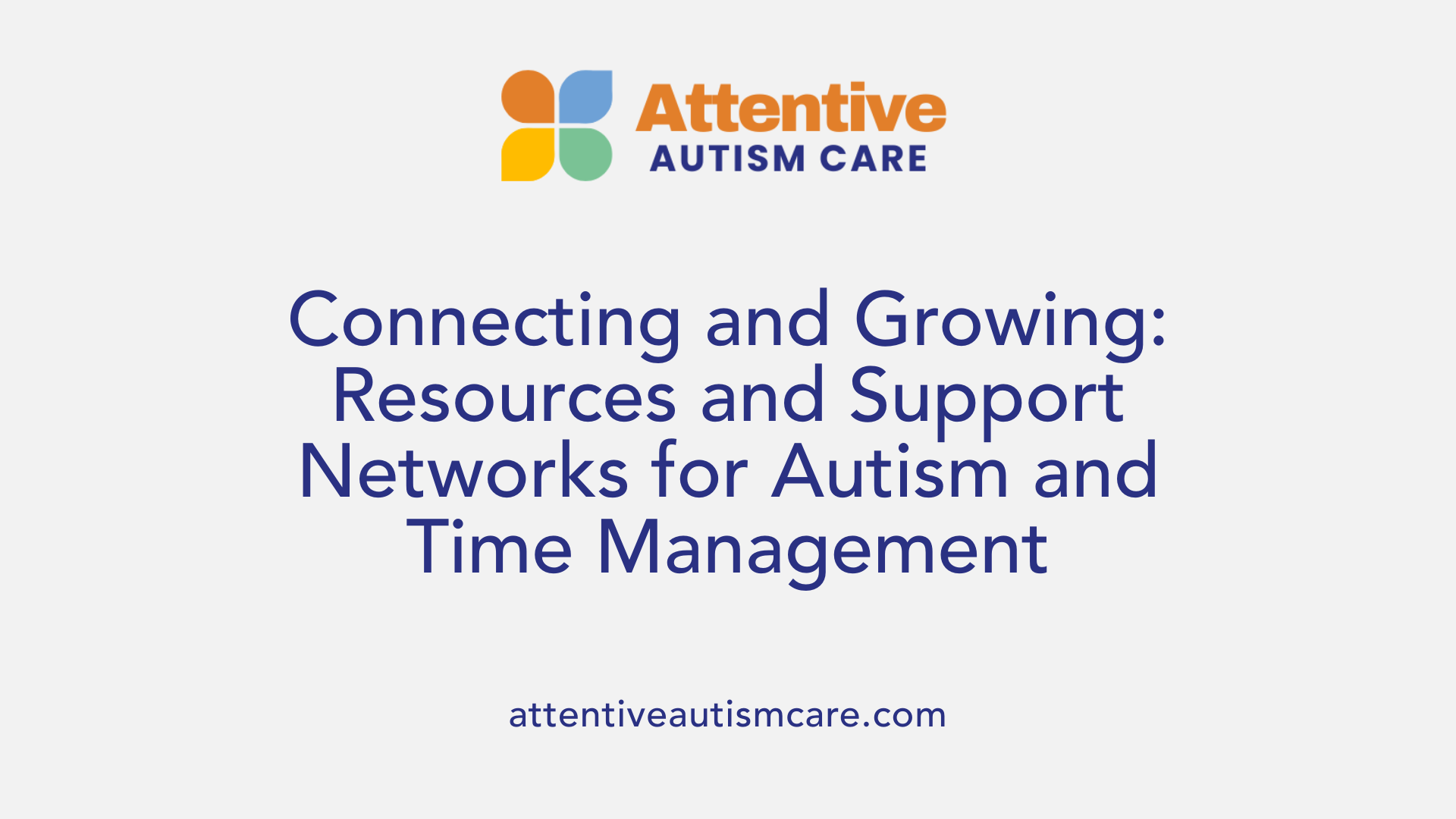The Impact of Autism on Time Management
Understanding How Autism Shapes Daily Routines and Time Perception

Introduction to Autism and Time Management Challenges
Autism spectrum disorder (ASD) impacts many facets of daily life, notably influencing how individuals perceive and manage time. This article explores the complex relationship between autism and time management, highlighting scientific insights, practical strategies, and available resources to support autistic individuals in navigating their daily routines more effectively.
The Neurobiological Basis of Time Perception in Autism

Which brain regions are involved in perception of time, such as the basal ganglia and cerebellar systems?
Research shows that the perception of time is linked to specific areas of the brain, mainly the basal ganglia and cerebellum. The basal ganglia are a group of structures deep within the brain that help control motor movements and play a role in cognitive functions like timing and decision-making. The cerebellum, located at the back of the brain, is traditionally associated with coordination and balance but also contributes significantly to timing and the prediction of sensory events.
These regions work together to process different aspects of time perception, from short intervals to longer durations. They analyze incoming information to help us perceive, judge, and estimate time accurately. Their proper functioning is essential for executing smooth movements, understanding sequences, and planning future actions.
How do these systems function differently in individuals with autism?
In autistic individuals, there are indications that the functioning of the basal ganglia and cerebellar systems may differ from neurotypical patterns. Studies suggest that these differences could be responsible for many of the unique challenges observed in time perception among people on the spectrum.
Specifically, research points to atypical neural activity in the basal ganglia and cerebellum, which may impair the ability to accurately perceive and estimate durations, especially for complex or longer intervals. While some individuals with autism may still demonstrate strong timing abilities—such as reproducing specific durations—they often face difficulties with tasks involving the sequencing of events, waiting, or adapting to changing time cues.
Neurophysiological studies, including EEG analysis, reveal that responses to temporal stimuli are often abnormal in autism, indicating differences in how these brain regions process timing information. These alterations could contribute to broader challenges with executive functioning, such as planning and transitioning between activities.
Understanding these neurobiological differences offers insights into why many autistic individuals experience difficulties with time management, routine adherence, and adapting to unpredictable schedules.
| Brain Region | Typical Role in Time Perception | Differences in Autism | Implications for Behavior and Functioning |
|---|---|---|---|
| Basal Ganglia | Control of motor timing and decision-making | Altered activity and connectivity | Difficulties with interval timing, sequencing, and decision processes |
| Cerebellum | Coordination and predictive timing | Structural differences observed | Challenges in predicting timing and managing movements or transitions |
Such findings highlight the importance of these brain systems in everyday functioning for autistic individuals, influencing how they perceive, react to, and manage time.
How Autism Alters the Experience of Time and Daily Functioning

How does autism affect time perception and management?
Autism can greatly influence how individuals perceive and handle time. Many autistic people experience challenges in understanding concepts like 'yesterday,' 'tomorrow,' or estimating how long tasks will take. These difficulties can impact everyday activities such as planning, sequencing events, and managing schedules.
Research suggests that the perception of time involves specific brain systems, notably the basal ganglia and cerebellar systems. In individuals with autism, differences or impairments in these areas may contribute to inconsistent time perception. For example, some autistic individuals may excel at reproducing durations in controlled tasks, demonstrating strength in certain timing abilities.
However, many face problems with tracking and gauging time, which can lead to misunderstandings of durations and sequences. These challenges often result in difficulties understanding the concept of future events like 'tomorrow' or past events like 'last week.' It can also make estimating how long activities will last confusing, affecting daily routines and responsibilities.
The variability in time perception among autistic individuals is significant. Some may develop a form of time blindness—struggling to estimate or perceive time effectively—leading to increased stress and difficulties with planning and organization. This is compounded by issues in executive functioning, which include planning, prioritizing, and flexible thinking.
Research indicates that these timing difficulties are linked to underlying neurological differences, especially involving the basal ganglia and cerebellar systems. Furthermore, autism-related sleep disturbances and genetic factors such as circadian gene mutations may also influence circadian rhythms and time perception.
Overall, while some autistic individuals show strengths in certain timing tasks, many experience notable challenges that affect their daily life. These differences make it crucial to employ tailored strategies to support effective time management, such as visual schedules, timers, and structured routines.
Variability in time reproduction abilities among autistic individuals
The ability to reproduce time intervals, such as reproducing a given duration or stringing together sequences over time, varies significantly among people on the spectrum. Some show remarkable accuracy in these tasks, indicating some intact or even enhanced timing skills. Others struggle, especially in environments demanding flexible adaptation.
Strengths like attention to detail and enhanced memory for routines can be advantageous, aiding in tasks like following a structured timetable or sticking to a fixed schedule.
Conversely, difficulties with understanding and estimating time can lead to problems in planning activities, transitioning between tasks, or coping with unstructured time.
Challenges in understanding time concepts such as yesterday, tomorrow, or duration estimation
Many autistic individuals find it hard to grasp basic time concepts such as the passage of days or the duration of activities. This can cause confusion when trying to understand sequences of events or differentiate between past, present, and future.
These challenges often manifest as struggles with everyday tasks like knowing how long chores should take, managing transitions, or understanding schedules. For children, this may translate into anxiety, meltdowns, or procrastination.
To address this, visual supports like schedules, timers, and countdowns are used to improve comprehension. Breaking tasks into smaller parts and providing clear, predictable routines can help build understanding. Tools like social stories and reinforcement through positive feedback further support developing these skills.
By acknowledging the variation in abilities and challenges related to time, caregivers and educators can implement strategies that foster better time awareness, improve independence, and reduce stress for autistic individuals.
Practical Strategies and Tools for Enhancing Time Management in Autism

What practical interventions support improving time management in autistic individuals?
Supporting autistic individuals in managing time effectively often involves a combination of visual supports, structured routines, and technological tools. Visual aids like schedules, timers, and alarms serve to enhance understanding of daily routines, sequence of activities, and the passage of time. These tools make abstract time concepts tangible, helping individuals anticipate upcoming tasks and transitions.
Timers and visual timers provide auditory and visual cues, helping to improve awareness of task durations and signal when to shift focus. Digital reminder apps and alarms can reinforce routines and prompt transitions, fostering independence. Breaking down complex activities into smaller, manageable steps reduces overwhelm and frustration, especially when paired with visual prompts. Establishing consistent routines offers stability, predictability, and reduces anxiety, making it easier to adhere to schedules.
Collaboration between caregivers, educators, and employers is essential. Providing accommodations—such as a quiet workspace or flexible timing—can create supportive environments that reinforce the development of time management skills. Using concrete methods, like everyday time markers or mental imagery, further supports understanding. Overall, a mix of visual tools, routine strategies, and tailored support forms a comprehensive approach to enhance time perception and organization abilities.
What are effective strategies to improve time management skills in autistic individuals?
Effective methods for boosting time management skills among autistic individuals center around visual supports and structured routines. Visual tools such as pictorial schedules, picture-based calendars, and color-coded organizational systems help individuals grasp the sequence and importance of tasks. These supports make planning clearer and regularize expectations, reducing confusion and anxiety.
Establishing predictable routines—such as fixed wake-up times, meal schedules, and consistent bedtime routines—provide a framework that fosters emotional security and stability. Chunking larger tasks into smaller, achievable steps, and setting timers or alarms for each segment helps individuals focus and transition smoothly between activities.
Assistive technology plays a pivotal role; apps designed specifically for time management, such as visual schedule apps like 'Choiceworks' or 'First Then Visual Schedule,' can reinforce routines and prompt actions. General productivity apps like 'Todoist' or 'Trello' support planning and prioritization. Teaching about time through visual aids, social stories, and explicit instruction cultivates comprehension and independence.
Supporting strategies also include creating environments with minimal distractions, encouraging practice and repetition, and involving the individual in planning to foster ownership of routines. Combining these approaches with caregiver or mentor reinforcement helps reinforce skills and reduce the stress often associated with time management challenges.
Overview of Support Techniques and Tools
| Support Type | Specific Tool/Strategy | Purpose/Benefit |
|---|---|---|
| Visual supports | Schedules, picture charts, color coding | Clarify routines, sequence tasks, reduce anxiety |
| Timers and alarms | Visual timers, countdown clocks | Signal time passing, aid transitions |
| Digital tools and apps | 'Choiceworks', 'First Then', calendar apps | Reinforce routines, prioritize tasks, support planning |
| Task segmentation | Breaking down activities into steps | Make activities manageable, boost confidence |
| Consistent routines | Fixed waking, eating, activity times | Provide stability and predictability |
| Support from professionals | Behavioral techniques, coaching | Personalized skill development |
Incorporating these different interventions can create a balanced and effective approach to improving time management skills. Tailoring strategies to individual preferences and needs—such as choosing preferred visual aids or preferred apps—further enhances their effectiveness.
Supporting Executive Functioning Skills for Better Organization and Planning

How does autism impact executive functioning skills related to organization and planning?
Autism often brings about significant challenges in executive functioning, which includes skills like organization, planning, flexibility, and task management. Many autistic individuals find it difficult to manage routines, sequence tasks, and prioritize their activities effectively.
These difficulties are usually rooted in deficits within brain systems responsible for executive functions, such as the basal ganglia and cerebellum. As a result, planning ahead, adapting to unexpected changes, and maintaining organized workflows can become overwhelming.
In real-life settings like school or work, these challenges manifest as trouble initiating tasks, staying on schedule, or adjusting when routines need to shift. This can lead to increased frustration, stress, or anxiety, especially during transitions or when faced with unstructured time.
Supporting these individuals requires specific strategies designed to strengthen their executive skills. Visual aids like schedules, checklists, and step-by-step guides help clarify task sequences. Structured routines provide predictability, which reduces overwhelm and boosts confidence.
The impact of impaired executive function extends beyond daily routines; it influences academic performance, job competence, and independence. Therefore, understanding these challenges is essential for developing effective interventions.
Strategies for improving executive functions such as flexibility, memory, and control
Enhancing executive functions involves tailored approaches that build skills gradually and reinforce independence. Important strategies include:
- Using visual supports like calendars, color-coded charts, and social stories to aid comprehension and sequencing.
- Breaking complex tasks into smaller, manageable steps to reduce cognitive load.
- Implementing consistent routines that offer stability and reduce anxiety.
- Employing timers and alarms to assist with time management and transitions.
- Incorporating technology tools such as organizational apps, timers, and voice recorders to aid memory and task tracking.
- Teaching flexibility through gradual exposure to changes and using visual warnings before transitions.
- Practicing planning skills, including pre-assessment of tasks and involvement in goal-setting.
- Teaching self-monitoring and self-control techniques, like self-checklists and progress tracking.
Furthermore, collaboration between parents, teachers, and therapists ensures a unified approach, reinforcing strategies across environments.
Explanation of how planfulness and flexibility influence daily functioning
Being able to plan effectively allows individuals to anticipate needs, prepare for upcoming events, and manage their time efficiently. When combined with flexibility, they can adapt to unforeseen changes or unexpected disruptions—critical skills for navigating daily life.
For autistic individuals, developing these abilities can lead to smoother transitions, less anxiety, and better participation in social and occupational settings. Tools like visual schedules and alarms promote a proactive approach to managing routines, while flexible strategies help them tolerate minor changes without distress.
Encouraging self-advocacy and decision-making also fosters independence. Recognizing that some level of rigidity may serve as a coping mechanism, support plans should balance structure and adaptability to suit individual preferences and needs.
Practical applications and supports for executive functioning
To bolster executive skills, interventions should include:
- Visual supports: charts, visual timers, schedules.
- Organizational tools: planners, checklists, digital apps.
- Routine development: establishing consistent daily activities.
- Transition strategies: warnings and countdowns.
- Cognitive-behavioral techniques: self-monitoring, problem-solving.
- Technology aids: apps like 'Choiceworks' or 'First Then', timers, and reminder systems.
Effective support involves teaching these skills explicitly and providing plenty of opportunities for practice.
Evidence-based insights and future directions
Research indicates that up to 80% of individuals with autism may experience executive function disorder, affecting their ability to manage time, complete tasks, and perform daily activities. Interventions that combine visual supports, technological tools, and structured routines have shown promising results.
Future advancements include personalized digital solutions that adapt to individual needs, improved training programs for caregivers, and integration of executive function strategies into educational curricula.
Overall, strengthening executive functions can significantly enhance independence, reduce behavioral issues, and improve quality of life for those on the autism spectrum. By understanding the specific challenges and applying evidence-based strategies, support systems can be tailored to promote better organization and planning skills.
Community Support, Resources, and Future Directions

Are there community or online support networks discussing autism and time management?
Many families, educators, and individuals on the autism spectrum connect through various online communities and support networks. These platforms serve as valuable sources of shared experiences, practical strategies, and emotional support. Notably, forums like Reddit and specialized autism support groups offer spaces where members discuss challenges related to time management and brainstorm solutions.
Participants often exchange tips on establishing routines, using visual schedules, and employing assistive technologies to improve time perception and organizational skills. These communities also provide encouragement and validation, helping members navigate the complexities of autism-related time challenges.
Are there educational resources available for helping caregivers and educators support children with autism in managing time?
Support for caregivers and educators is abundant, offering a range of resources tailored to enhance time management in children with autism. Visual aids such as daily schedules, timers, alarms, and task chunking tools can be integrated into classroom routines or home settings.
Professional guidance from experts like Dr. Cathryn Lehman highlights effective techniques, including the use of visual supports, breaking tasks into smaller steps, and establishing consistent routines to foster predictability and reduce anxiety.
Numerous educational programs and materials are designed to build these skills, including tools like the School Community Toolkit, which offers strategies for behavioral support and structured routines. Assistive technology, such as apps like 'Choiceworks' and 'First Then Visual Schedule,' also play a supporting role in teaching time estimation and organization.
Workshops, online courses, and books by specialists in autism education provide in-depth guidance on implementing these strategies effectively. Collaboration between parents, teachers, therapists, and autism organizations ensures that support systems are comprehensive and personalized, promoting independence and reducing stress related to time management in children with autism.
The future of support emphasizes integrating digital tools with physical supports and expanding access to training and resources. Continuous research gives insights into brain-based differences impacting time perception, leading to innovations in intervention strategies that can be scaled across different contexts.
In summary, a variety of community-led and professional resources exist to empower caregivers and educators. These tools and networks aim to foster improved time management skills, helping children and adults on the spectrum achieve greater independence and a better quality of life.
| Support Type | Description | Additional Notes |
|---|---|---|
| Online Communities | Reddit, autism forums, Facebook groups | Share personal experiences, tips, and emotional support |
| Educational Resources | Visual schedules, timers, alarms, task breakdowns | Support classroom and home routines |
| Professional Guidance | Expert consultations, workshops, training programs | Emphasize individualized strategies |
| Assistive Technologies | Apps, digital timers, visual aids | Enhance organization, planning, and time estimation |
| Books and Courses | Published materials on autism and time skills | Offer in-depth understanding and practical approaches |
By leveraging these networks and resources, caregivers and educators can better support individuals with autism in navigating the challenges of time perception and management. As research advances, these tools will continue to evolve, offering even more tailored and effective solutions.
Empowering Individuals and Caregivers
Understanding the nuances of how autism affects time perception and management is crucial for developing effective support strategies. By leveraging scientific insights, tailored interventions, and community resources, caregivers, educators, and autistic individuals themselves can improve daily functioning, reduce anxiety, and foster greater independence. Emphasizing routine, visual supports, assistive technologies, and professional guidance creates a comprehensive approach to address the unique challenges faced by those on the spectrum in managing time.
References
- Autism and time management
- Time Management and Other Executive Functioning Issues in the ...
- 7 Effective Time Management Strategies for Autism
- Organising and prioritising - a guide for all audiences
- Autism Time Management Skills - Golden Care Therapy
- Autism and executive functioning skills - Leicestershire Partnership ...
- Mastering Time Management: Key Skills for Students with ASD
- Time Blindness on Individuals With Autism - entivabehavioralhealth




































































































